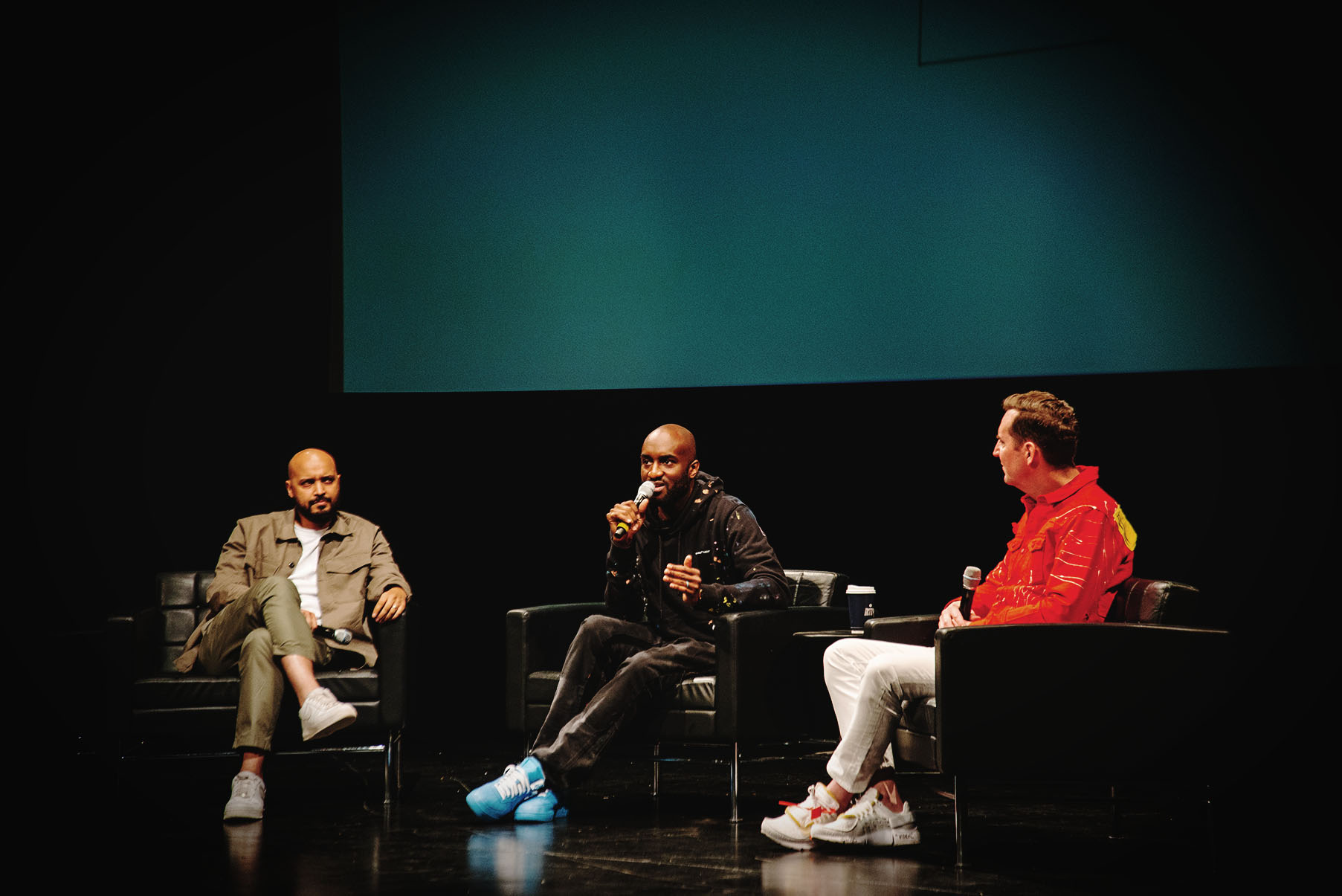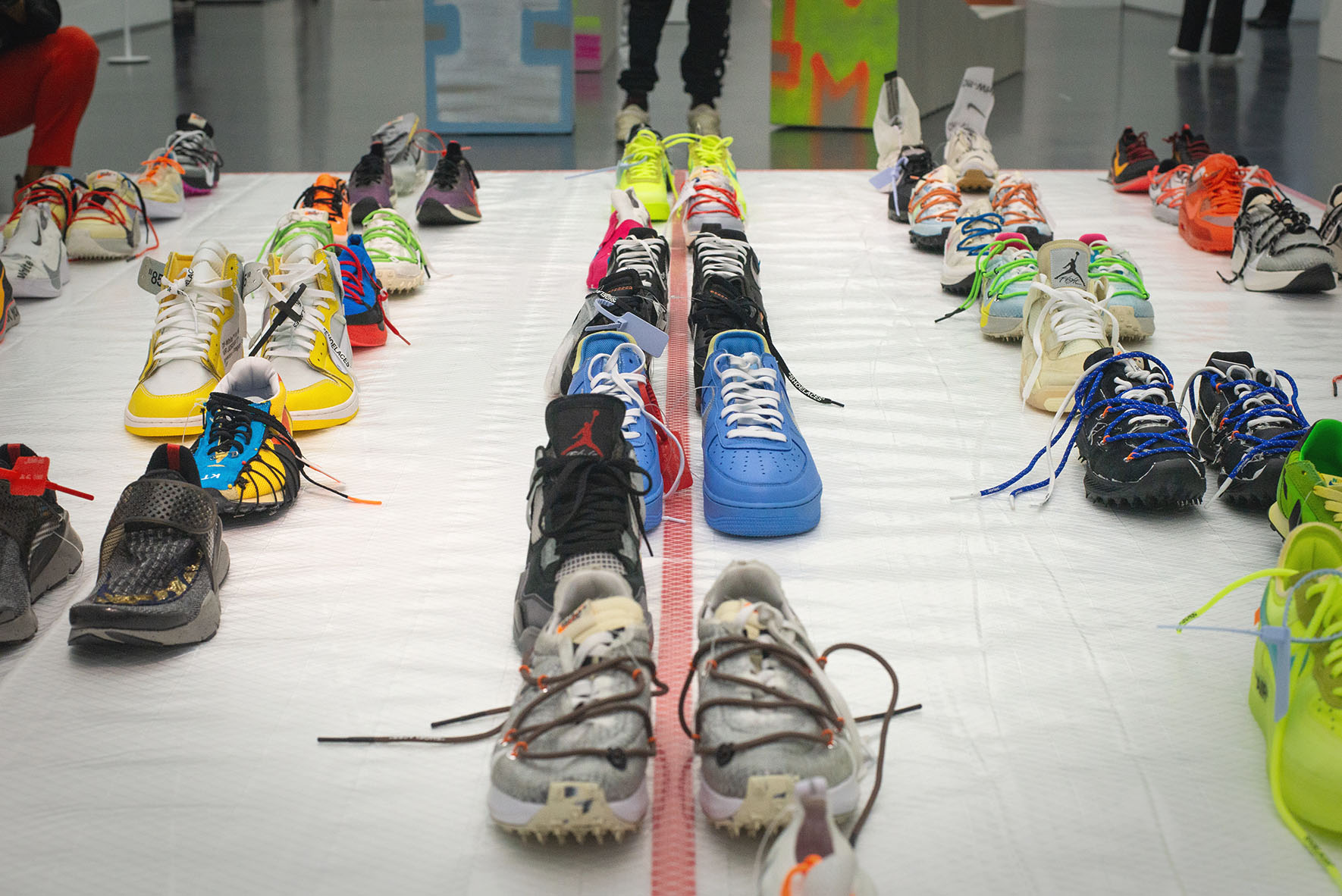Virgil Abloh gained prominence by way of casual namedrops on Kanye West albums and guest appearances at the rapper’s fashion shows. But more recently, as he has climbed in status toward visionary, the thirty-eight-year-old fashion designer’s name stands on its own merit. Abloh’s latest exhibit at the Museum of Contemporary Art Chicago, entitled “Figures of Speech,” serves as retrospective recounting of his career, from his time as an architecture student at the Illinois Institute of Technology to the genesis of his Milan-based fashion house Off-White and his 2018 position as Men’s Artistic Director of Louis Vuitton.
At a press preview of the exhibit on June 7, Abloh joined MCA Chief Curator Michael Darling and Samir Bantal, director of research and design studio AMO for a conversation. Darling took the museum’s Edlis Neeson stage decked in an outfit appropriately garnished with Abloh’s Off-White branding on his back. If there could be a singular takeaway from this conversation, it was that this exhibit is Abloh’s way of, as he put it, “having a dialogue with the youth of Chicago that have the same skin tone as me.” The word that best encapsulates the museum and Abloh’s mission with this exhibit is “accessibility.” It remains to be seen whether this mission succeeds.
The world of high fashion has routinely heralded itself as a champion of progressive thinking and boundary breaking practices, but has long remained inaccessible to most people. As contemporary art continues to intersect with the fashion world and lunges toward commercialism, it threatens to become equally inaccessible. While Abloh’s words convey messages of accessibility and opportunity, the exhibit and the accompanying pop-up shop, entitled “Church & State,” weave a different narrative. The highly collaborative store occupies the museum’s fourth floor Turner Gallery space often used for smaller exhibitions and screenings. Among the items for sale are the exhibit’s art book, priced at sixty-five dollars, a poster set for $140, and Off-White hoodies priced at over $600.
Abloh has said that he was always given feedback that Off-White was “super expensive” and unaffordable. This is partly why he wanted to collaborate with IKEA, for what Abloh calls their “democratic design, and ubiquity.” The use of things that are ubiquitous is seen throughout Abloh’s work. In the exhibit’s audio accompaniment, Amy Verner, contributing editor to Vogue Runway, relays how Virgil “wanted Off-White, from the very beginning, to be perceived as luxury,” injecting it with a sort of youthfulness and familiarity to redefine what luxury can be, but luxury nonetheless is often inaccessible and unattainable by many. This positioning of Abloh’s fashion house contradicts the notion of the brand being something for everyone. And this pattern of repurposing symbols and ideas from places more familiar to the general public when utilized for luxury and highly accessible products seems like nothing more than appropriation.
When you enter “Figures of Speech,” one of the first pieces that greets you is a portrait of Virgil sitting with a shirt atop his head while a European flag rests behind him. The caption to the side of the portrait serves as a mini-introduction to Virgil and his many influences. The caption specifically praises how his work blends influences from the downtown New York queer scene. But because these injections into luxury aren’t repurposed or done for the benefit of those who created this scene, the work feels less about equity and more about commodification.

Abloh’s contemporary and co-founder of No Vacancy Inn, Tremaine Emory, likened Abloh’s process to that of Andy Warhol. In the audio accompaniment to the exhibit, Emory explained that, like Warhol, Abloh shares an understanding of confluence, of zeitgeist, and of high-low culture—the micro from the macro. The aptness of this comparison is reflected in a piece where Abloh screen-printed a Caravaggio painting over multiple boards of Pyrex. Like Warhol, who utilized the bridge between art and commercialism and mended them into a single entity, Abloh borrows from the worlds of art and music and implants elements of them into his fashion work, dismantling the barriers between the different worlds. And both artists also took ideas and influence from less visible cultures and repurposed them for a higher-paying audience.
Yet, not all of what surrounds “Figures of Speech” negates the message of accessibility. One of the direct resources the show provides is the Design Challenge, a competition open to those between the ages of fourteen and twenty-one, with prizes including apparel, an Instagram video production, and a meet-and-greet with Abloh. The challenge asks for a response to the prompt: “Take something boring or broken and turn it into something extraordinary,” posted to Instagram with the challenge’s hashtag. Along with this challenge, various events throughout the residency directly respond to the disparity between fashion and culture, for example promoting sustainability and the origins of streetwear. Despite the initiative to use the platform to increase the diversity of the fashion world, much of the program and its events reflect perhaps less so the museum’s own mission of accessibility, but rather Abloh and his own message.
Often when those of affluence and influence speak about accessibility, the conversation becomes less about giving visibility to the process, to the tools, or to the opportunities, and more of an attempt to create more consumers. When a retrospective exhibit like “Figures of Speech” attempts to peel back the curtain on a creator, what should become accessible is the process—not the product.
For better or worse, Abloh’s exhibit redefines what we can be considered as art. What fills the space subverts what many traditionally expect within the halls of a museum: contemporary garments, blown-up magazine ads, luxury store mannequins and framed Supreme t-shirts. Abloh has said, “I don’t feel responsible to preconceived notions of art. I feel more responsible to a community that is trying to change the tide or—just sort of—live in an optimistic society that art, design, music, and fashion actually change the world for the better.” And his contemporary, Tremaine Emory, has spoken similarly: “Streetwear, like hip-hop music, punk music, blues music, jazz music, communicates the struggles, hopes, joys, dreams, and the art of the subculture, the downtrodden, the underdog.” Nevertheless, “Figures of Speech” speaks more as an advertisement than an exhibition.
“Figures of Speech.” Museum of Contemporary Art, 220 E. Chicago Ave. Through September 22. Suggested donation $8–$15. (312) 280-2660. mcachicago.org
Efrain Dorado is a contributor to the Weekly and lives in Chicago.

